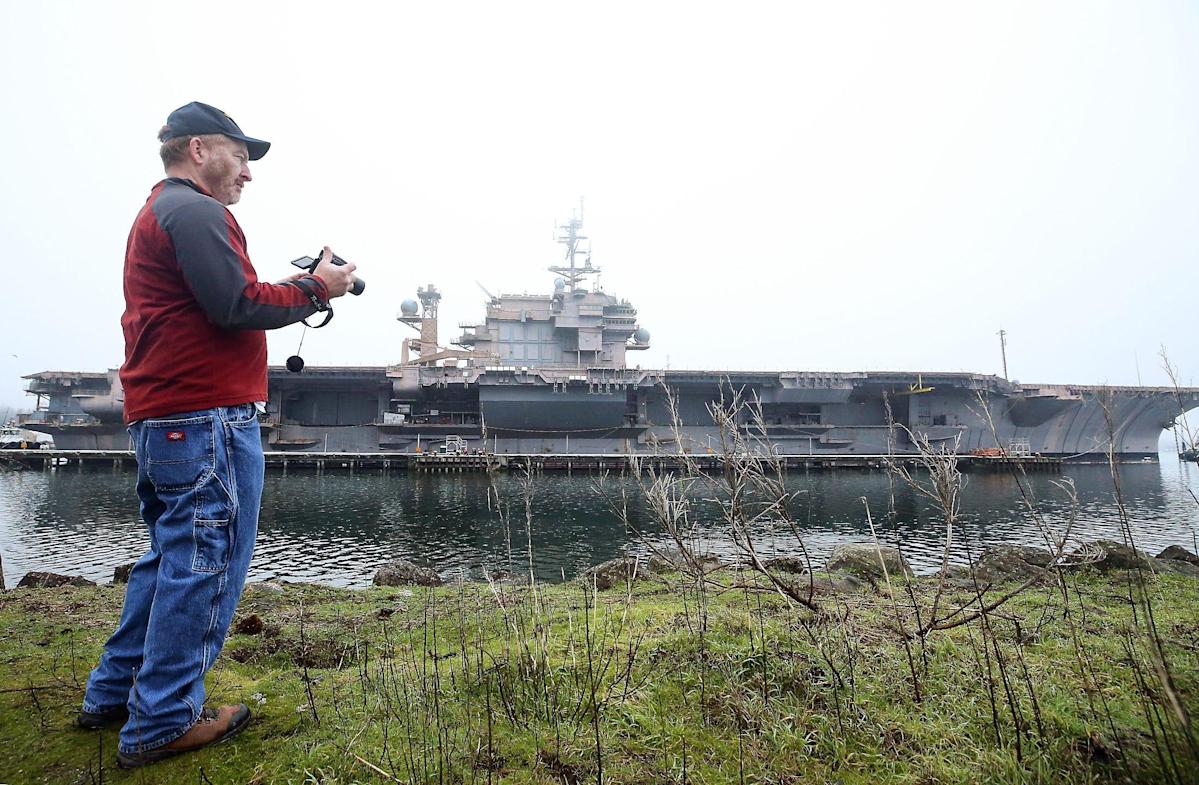BREMERTON — The USS Kitty Hawk, the nation’s last oil-fired aircraft carrier, departed Bremerton on Saturday for a 16,000-mile journey around South America for its ultimate fate: scrapping at a Texas shipyard.
Onlookers, many of them former sailors aboard the “Battle Cat,” watched as tugs pulled the rugged warship into Sinclair Inlet on a foggy Saturday morning. At more than 1,000 feet long, the Kitty Hawk won’t fit in the Panama Canal, so the warship will be tugged through the Strait of Magellan en route to Brownsville, Texas.
Corey Urband, a Navy veteran who became a machinist at the Puget Sound Naval Shipyard, was among those old sailors gathered to see it go. Many swapped stories of being thrust onto a Navy ship, put in charge of millions in equipment and the care of thousands of lives.
“As hard as life was on this ship, it’s part of my history,” said Urband, who served from 1992 to 1996 as a machinist’s mate. “While most people were graduating from high school and college, I was 30 feet below the waterline, halfway around the world from home.”
For Rich Bratlee, an electrician from Spanaway, the Kitty Hawk was an eye-opening rite of passage. The 6,000 sailors of the Kitty Hawk were double the size of his hometown in Montana.
“Quite a culture shock,” said Bratlee, who served from 1979-1983 and watched the ship depart Bremerton on Saturday. “I’ve come a long ways since being a kid on a farm.”
The massive ship had two escalators to help move around thousands of sailors more easily. Yet it never seemed to work well, sailors say. At times too many people would propel the escalator forward, spilling those at the bottom into a pileup.
“The were nothing but a pain,” Bratlee said.
The Kitty Hawk follows from Bremerton’s mothball fleet the USS Constellation, USS Independence and USS Ranger, which were all dismantled at the same place: International Shipbreaking Ltd. The company contracted for the warship, along with fellow carrier USS John F. Kennedy, for the stately price of one cent.
“The contract values reflect that the contracted company will benefit from the subsequent sale of scrap steel, iron, and non-ferrous metal ores,” said Alan Baribeau, a spokesman for the Naval Sea Systems Command.
More: USS Kitty Hawk veterans devastated the aircraft carrier is headed for the scrapyard
The Kitty Hawk got a rare visit to one of the Navy’s only two carrier dry docks in 2021 so that its marine growth could be scraped off. Under an agreement with the state, Suquamish Tribe and other groups, the ship’s hull could not be cleaned in Sinclair Inlet after a previous carrier’s scrubbing sparked environmental concerns.
More: Former Kitty Hawk aircraft carrier leaves dry dock in Bremerton
The Kitty Hawk participated in combat operations during the nation’s wars in Vietnam, Afghanistan and Iraq. The Kitty Hawk was also the fleet’s only permanently forward-deployed carrier in Yokosuka, Japan, from 1998 to 2008. It was decommissioned a year later and has been in mothballs in Bremerton until this year.
Five former aircraft carriers have been turned into museums, but the Kitty Hawk will not be one of them. Though many sailors and others advocated for its preservation, the Navy declined to pursue that course. Advocates worried that there will never be another carrier preserved for posterity, as those of the nuclear-powered era must be mangled to remove all radioactive remnants. The San Diego-ported USS Midway, a flattop that served from 1945 to 1992, was the last the Navy turned into a museum.
More: Former Kitty Hawk aircraft carrier leaves dry dock in Bremerton
Kitty Hawk history: a timeline
1956: The keel is laid by New York Shipbuilding Corporation for the second ship named after Kitty Hawk, N.C., site of the Wright brothers’ first flight.
1961: The USS Kitty Hawk is commissioned in 1961 at Philadelphia Naval Shipyard.
1963: The “Battle Cat” conducts “experiments” to find out if the U2 high-altitude reconnaissance planes could land on a carrier.
1969: The flattop is awarded a presidential unit citation for its participation off Vietnam during the Tet Offensive.
1972: A race riot aboard the ship ended with almost 60 injured men and “initiated reforms in the Navy culture.”
1984: The carrier collides with a surfacing Russian submarine in the Tsushima Strait, leaving the sub’s propeller embedded in the carrier’s hull.
1992: Kitty Hawk supports Operation Restore Hope off Somalia.
1998: The warship pulls into Yokosuka, Japan, to serve as the forward-deployed carrier in the 7th Fleet.
2003: The carrier and its crew are a part of Operation Iraqi Freedom.
2009: The Kitty Hawk is decommissioned and brought to its new home at the Navy’s mothball fleet in Bremerton.
2017: The Navy announces the Kitty Hawk will be dismantled, disappointing sailors and others who called for the ship’s preservation as a museum.
2021: The Kitty Hawk’s hull is scraped in the Puget Sound Naval Shipyard to remove marine growth and prepare it for the journey to Texas.
2022: The ship departs Bremerton.
Josh Farley is a reporter covering the military and Bremerton for the Kitsap Sun. He can be reached at 360-792-9227, [email protected] or on Twitter at @joshfarley.
This article originally appeared on Kitsap Sun: Old carrier USS Kitty Hawk departs Bremerton for Texas dismantling


